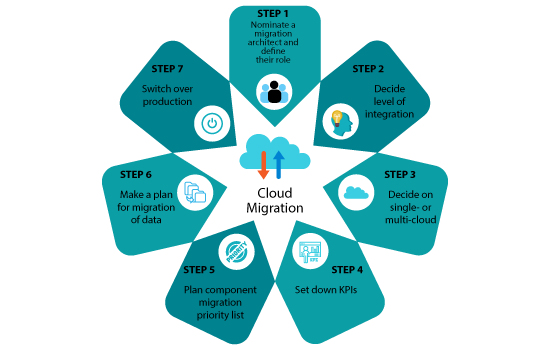
Cloud computing is gaining momentum across the world, and India is no different. Nasscom India estimates Indian spending on Infrastructure-as-a-service (IaaS), which is just one aspect of cloud computing, to have been around $ 1 billion in 2018, and is forecasting growth to reach $ 2.3–2.4 billion by 2022 (that’s 25 % y-o-y!). As a managed cloud services company and partner to the big three, i.e. AWS, Azure, and Google Cloud Platform (GCP), Teleglobal has helped diverse organizations make the move to cloud, and in the process gained special insights into best cloud migration practices. Here are the top seven ways enterprises can prepare to migrate to AWS.
1. Take the plunge
A journey of a thousand miles starts with a single step, and includes your cloud journey. That means stop stalling and get cracking. Over-planning can lead to paralysis. All you really need is a team comprising two or three engineers to get cracking. That means, opening an account on AWS account and play around with the console. Get familiar with the console and the environment, acquire basic skills and gain confidence. There will be queries aplenty, but so are the answers; many other enterprises have been where you are; you can learn from their problems and solutions.
It’s all there on the world wide web. And it’s free—mostly.
2) Get a Backer
Any change that threatens to disrupt the current way of doing things produces resistance. The fastest way to dissipate this resistance is to enlist the support of a senior leader willing to own the program and provide strategic direction. It helps if the program is led by the organization’s CIO or CXO; someone who can handle critical aspects, for example: aligning technical actions with business objectives, re-jigging goals—short and long term; and managing shareholder expectations inside and outside the organization.
3) Agree on Migration Goals
it is important that everyone knows and there is consensus about the migration’s business goals. This could be anything from desire to reduce costs; to accomplish digital transformation goals; shut down a datacentre…
Agreement on business and technical goals can be gained through discussions about specifics, and clarity about goals. This is important as it brings coherence to the organization’s Cloud journey. Our experience with cloud migrations has shown us that organizations can avoid many obstacles if there is convergence of expectations amongst stakeholders—for instance balancing the need for agility with security and compliance.
4) Clarify all queries with AWS/Partner
As you begin to get to grips with your move, multiple queries will crop up; don’t ignore them; make a note, in fact, gather all your various stakeholders and collate the different queries. Then schedule a meeting with AWS or your chosen AWS certified partner to resolve your doubts and queries. Such discussions are very helpful in giving you a big picture view as well as the inputs you need to make the right tactical and strategic decisions. Rather than hazarding a hunch or working through experiences of , say, your network of peers or associates, it is better to tap the accumulated knowledge of an experienced partner who would have hands-on experience with migrating hundreds of servers and thus understands various complexities of migration, has in-depth knowledge of AWS and can help you attend to licence-and-pricing matters.
5) Build Your Governance Framework:
Depending on the regulatory requirements of their business, individual organizations should align security and compliance goals and design their security strategy accordingly.
Furthermore, the organization should mandate a migration team whose responsibility includes understanding of shared responsibilities and development of a framework of best practices, this includes who to provide access to; what kind of resources they can access; how to monitor access, protocols to flag issues and take remedial measures automatically.
While AWS partners have the industry certifications to ensure physical security of your data, the onus is on the customer to secure access to server, network and data, and to configure it as per pre-decided norms.
6) Keep Stakeholders in the Loop
Ensure you put in place a communication strategy that informs stakeholders about the new model, and changes as you align/optimize existing systems and processes as it evolves.
For instance, your purchase department must learn how to manage operating expenditure; your legal team must become aware of the new implications in the cloud-model. Remember, success depends on user adoption, so every stakeholder should be aware of behavioural changes especially those that impinge on adherence to governance framework for meeting security and compliance.
7) Hire/Acquire the Needed Skilled Resources:
While it may be tempting to rely on in-house resources to manage your cloud; our customers invariably find that they’re better off with either up-skilling their existing team through trainings and certifications, or handing over certain responsibilities to a proven managed services provider, who has the technical expertise and experience to keep your cloud ecosystem humming along.
As an AWS Premier Consulting Partner, Teleglobal has the resources and knowledge capital to establish a strong operational base for your migration. Our proven migration methodology, informed through years of successful migrations, includes a methodical protocol and a proven tool-box of expertises to accelerate almost any migration scenario.
We can take over the drudgery of your migration, and the management and maintenance of your IT ecosystem, leaving you free to focus on core business strategy and operations.
No more expending time, money and effort on issues like scalability, agility and time-to-market: AWS Cloud frees businesses to focus on expansion and differentiation.







































